1974 CHEVROLET CAMARO tire pressure
[x] Cancel search: tire pressurePage 14 of 85
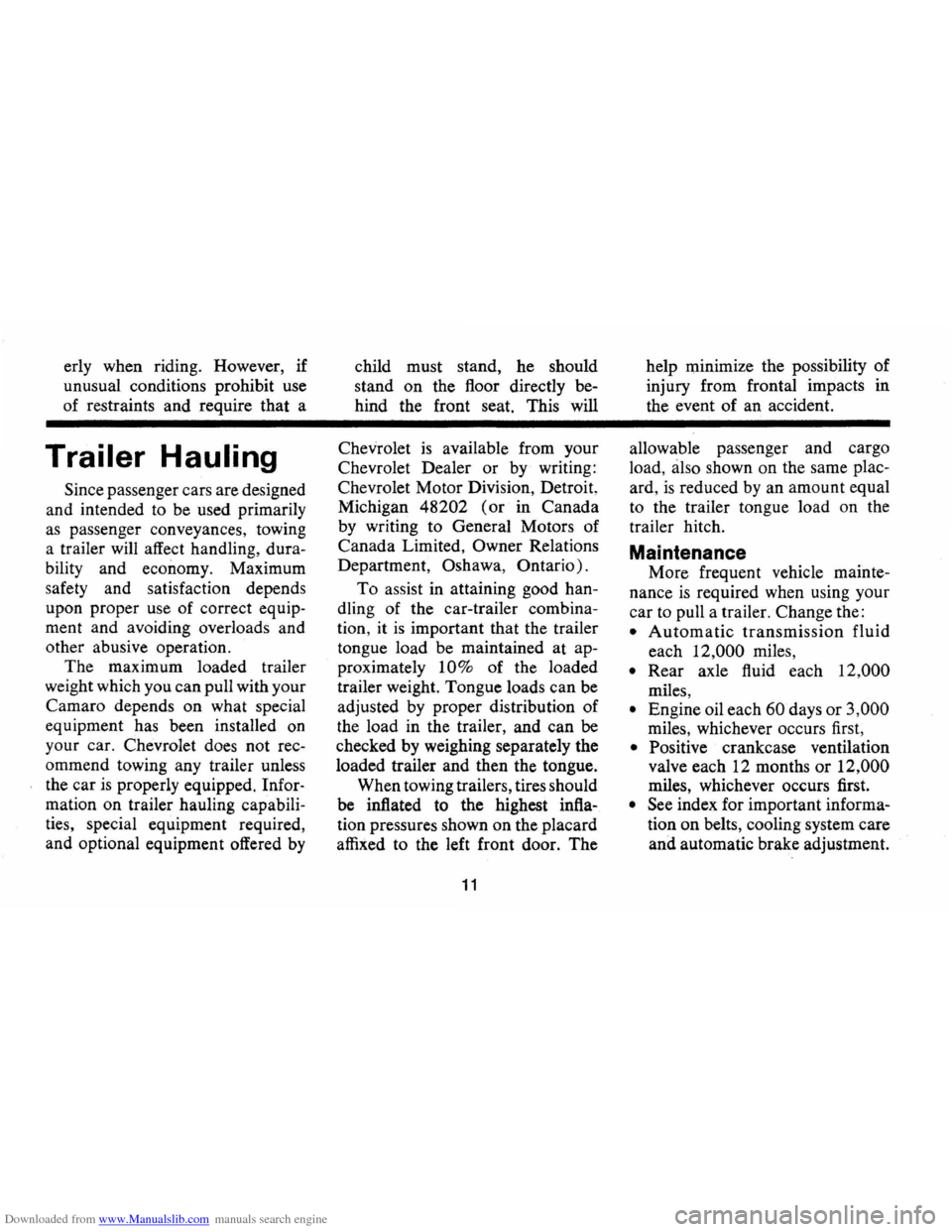
Downloaded from www.Manualslib.com manuals search engine erly when riding. However, if
unusual conditions prohibit use
of restraints
and require that a
Trailer Hauling
Since passenger cars are designed
and intended to be used primarily
as passenger conveyances, towing
a trailer will affect handling,
dura
bility and economy. Maximum
safety and satisfaction depends
upon proper use of correct
equip
ment and avoiding overloads and
other abusive operation.
The maximum loaded trailer
weight which you
can pull with your
Camaro depends on what special
equipment has been installed on
your car. Chevrolet does not
rec
ommend towing any trailer unless
the
car is properly equipped. Infor
mation on trailer hauling capabili
ties, special equipment required,
and optional equipment offered by child
must stand,
he should
stand
on the floor directly be
hind the front seat. This will
Chevrolet
is available from your
Chevrolet Dealer
or by writing:
Chevrolet
Motor Division, Detroit,
Michigan
48202 (or in Canada
by writing to General Motors of
Canada Limited, Owner Relations
Department,
Oshawa, Ontario).
To assist in attaining good han
dling of the car-trailer combina
tion, it is important that the trailer
tongue load be maintained
at ap
proximately 10% of the loaded
trailer weight. Tongue loads
can be
adjusted by proper distribution of
the load in the trailer,
and can be
checked by weighing separately the
loaded trailer and then the tongue.
When towing trailers, tires should
be inflated to the highest
infla
tion pressures shown on the placard
affixed to the left front door. The
11
help minimize the possibility of
injury from frontal impacts in
the event of an accident.
allowable passenger
and cargo
load, also shown
on the same plac
ard, is reduced by an amount equal
to the trailer tongue load on the
trailer hitch.
Maintenance
More frequent vehicle mainte
nance is required when using your
car to pull a trailer. Change the:
• Automatic transmission fluid
each
12,000 miles,
• Rear axle fluid each 12,000
miles,
• Engine oil each 60 days or 3,000
miles, whichever occurs first,
• Positive crankcase ventilation
valve each 12 months
or 12,000
miles, whichever occurs first.
• See index for important informa
tion on belts, cooling system care
and automatic brake adjustment.
Page 39 of 85
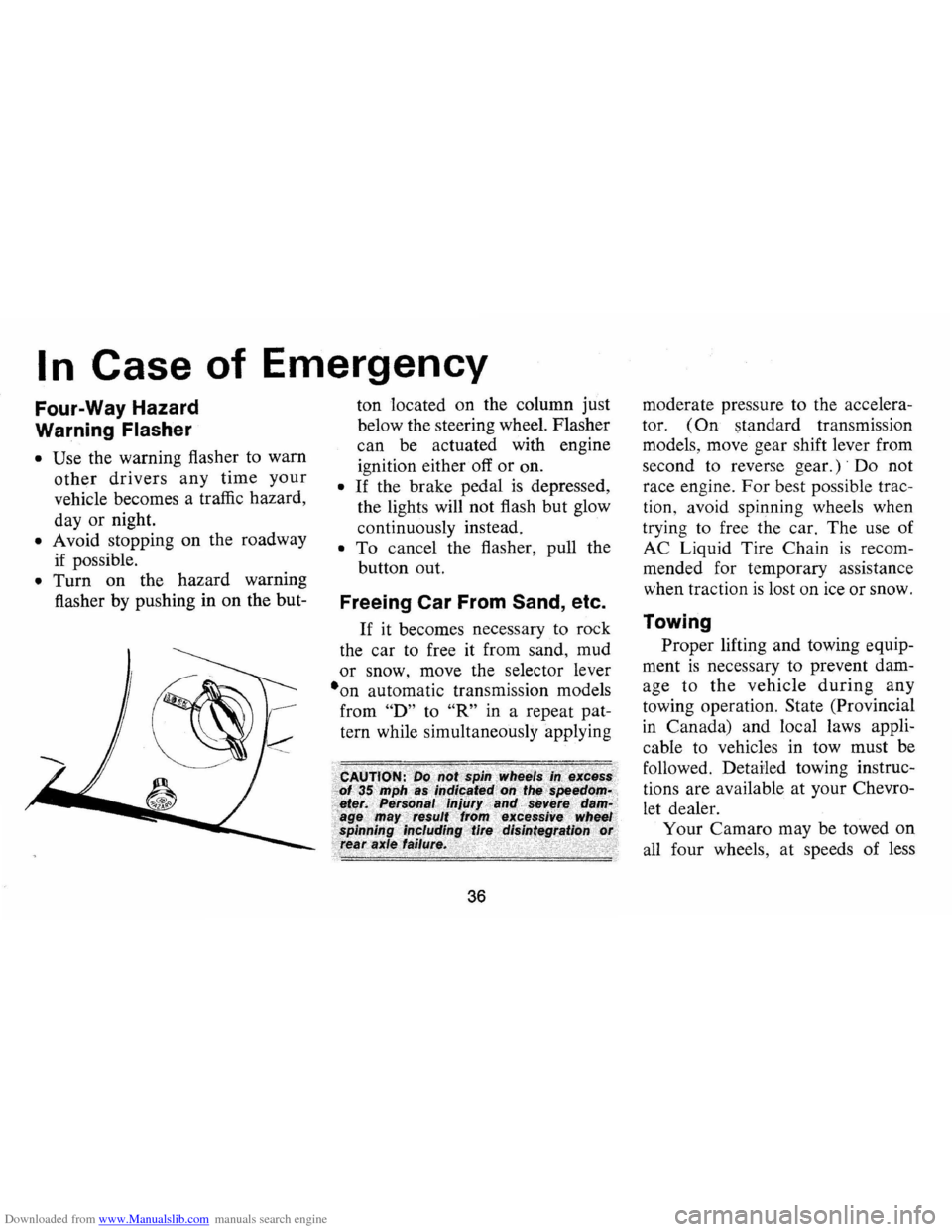
Downloaded from www.Manualslib.com manuals search engine I n Case of Emergency
Four-Way Hazard
Warning
Flasher
• Use the warning flasher to warn
other drivers any time your
vehicle becomes a traffic hazard,
day
or night.
• Avoid stopping on the roadway
if possible.
• Turn on the hazard warning
flasher by pushing in on the but- ton
located on the column just
below the steering wheel. Flasher
can be actuated with engine
ignition either off
or on.
• If the brake pedal is depressed,
the lights will not flash but glow
continuously instead.
• To cancel the flasher, pull the
button out.
Freeing Car From Sand, etc.
If it becomes necessary to rock
the car to free it from sand, mud
or snow, move the selector lever
·on automatic transmission models
from
"D" to "R" in a repeat pat
tern while simultaneously applying
36
moderate pressure to the accelera
tor.
(On standard transmission
models, move gear shift lever from
second to reverse
gear.)' Do not
race engine.
For best possible trac
tion, avoid spinning wheels when
trying to free the car. The use of
AC Liquid Tire Chain
is recom
mended for temporary assistance
when traction
is lost on ice or snow.
Towing
Proper lifting and towing equip
ment
is necessary to prevent dam
age to
the vehicle during any
towing operation. State (Provincial
in Canada) and local laws appli
cable to vehicles in tow must be
followed. Detailed towing instruc
tions are available at your Chevro
let dealer.
Your Camaro may be towed on
all four wheels, at speeds of less
Page 46 of 85
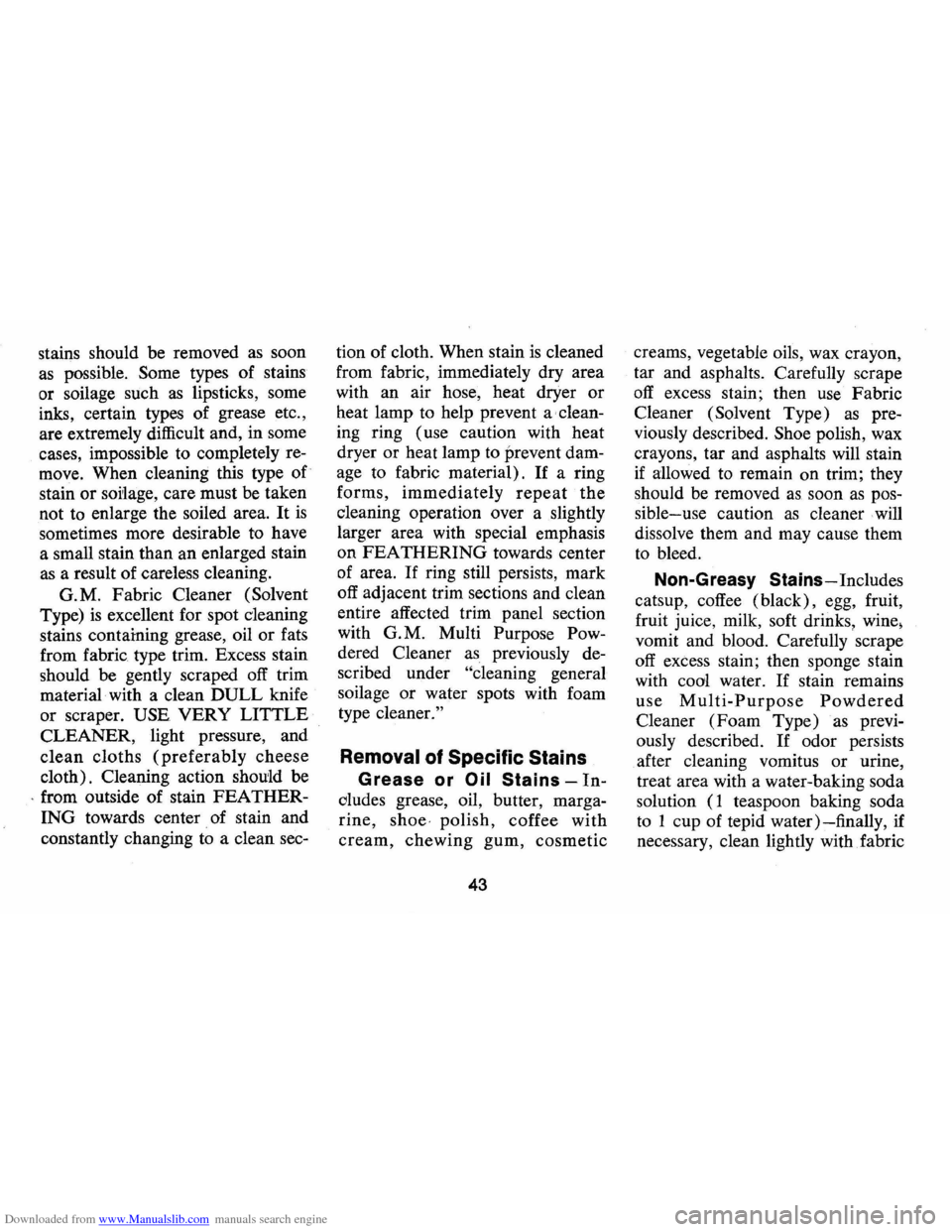
Downloaded from www.Manualslib.com manuals search engine stains should be removed as soon
as possible. Some types of stains
or soilage such
as lipsticks, some
inks, certain types of grease etc.,
are extremely difficult and, in some
cases, impossible to completely re
move. When cleaning this type
of'
stain or soi'lage, care must be taken
not to enlarge the soiled area.
It is
sometimes more desirable to have
a small stain than an enlarged stain
as a result of careless cleaning.
G.M. Fabric Cleaner (Solvent
Type)
is excellent for spot cleaning
stains containing grease, oil or fats
from fabric type trim. Excess stain
should be gently scraped off trim
material with a clean
DULL knife
or scraper.
USE VERY LITTLE
CLEANER, light pressure, and
clean cloths (preferably cheese
cloth). Cleaning action should be
, from outside of stain FEATHER
ING towards center of stain and
constantly changing to a clean sec- tion
of cloth. When stain
is cleaned
from fabric, immediately dry area
with an air hose, heat dryer or
heat lamp to help prevent a clean
ing ring (use caution with heat
dryer or heat lamp to prevent dam
age to fabric material).
If a ring
forms,
immediately repeat the
cleaning operation over a slightly
larger area with special emphasis
on
FEATHERING towards center
of area.
If ring still persists, mark
off adjacent trim sections and clean
entire affected trim panel section
with G.M. Multi Purpose Pow
dered Cleaner as previously de
scribed under
"cleaning general
soilage
or water spots with foam
type
cleaner."
Removal of Specific Stains
Grease or Oil Stains -In
cludes grease, oil, butter, marga
rine,
shoe· polish, coffee with
cream, chewing gum, cosmetic
43
creams, vegetable oils, wax crayon,
tar and asphalts. Carefully scrape
off excess stain; then use Fabric
Cleaner (Solvent Type)
as pre
viously described.
Shoe polish, wax
crayons, tar and asphalts will stain
if allowed to remain on trim; they
should be removed
as soon as pos
sible-use caution
as cleaner will
dissolve them and may cause them
to bleed.
Non-Greasy Stains-Includes
catsup, coffee (black), egg, fruit,
fruit juice, milk, soft drinks,
wine,
vomit and blood. Carefully scrape
off excess stain; then sponge stain
with cool water.
If stain remains
use
Multi-Purpose Powdered
Cleaner (Foam Type) as previ
ously described.
If odor persists
after cleaning vomitus or urine,
treat area with a water-baking soda
solution
(1 teaspoon baking soda
to 1 cup of tepid water)-finally, if
necessary, clean lightly with fabric
Page 52 of 85
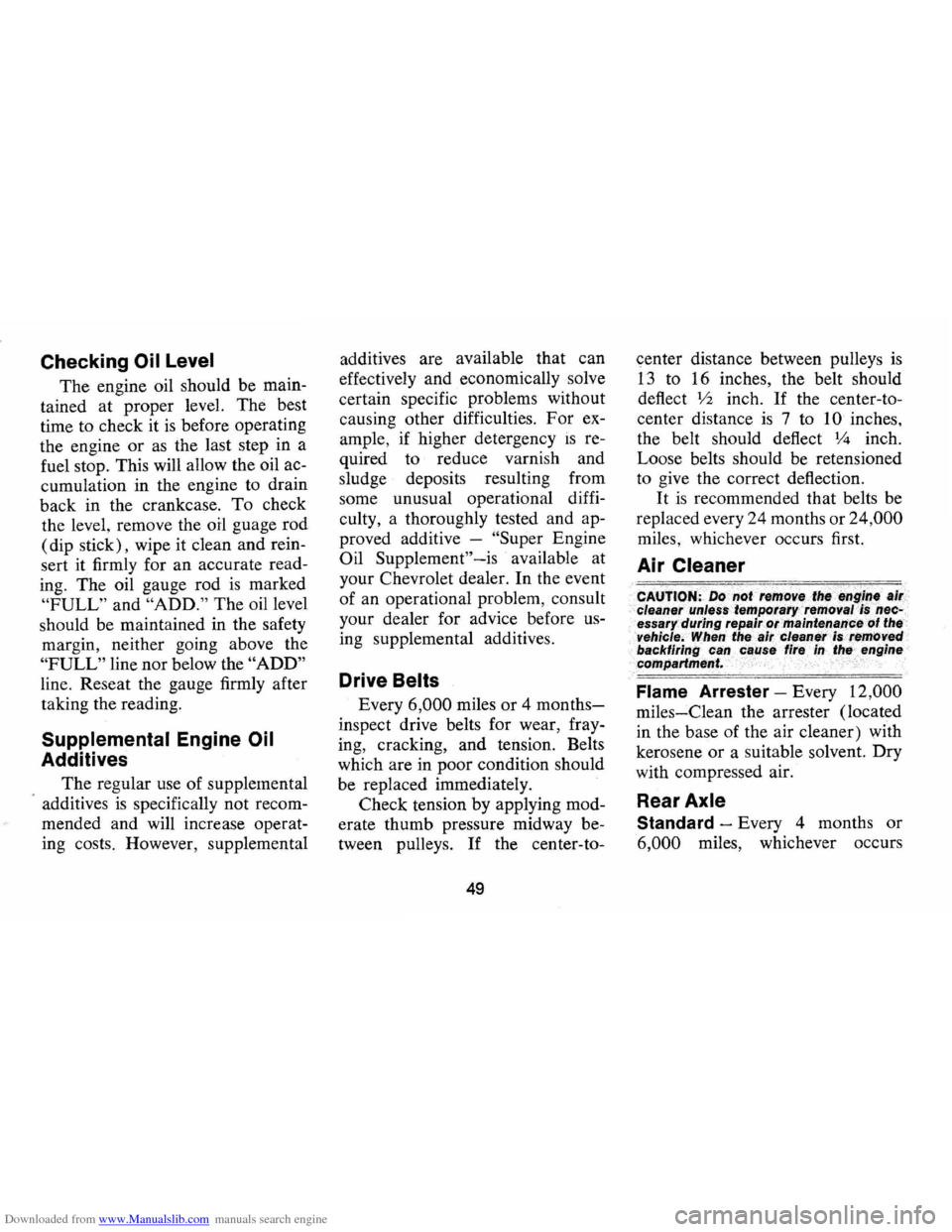
Downloaded from www.Manualslib.com manuals search engine Checking Oil Level
The engine oil should be main
tained at proper level. The best
time to check it
is before operating
the engine or
as the last step in a
fuel stop. This will allow the oil ac
cumulation in the engine to drain
back in the crankcase.
To check
the level, remove the oil guage rod
(dip stick), wipe it clean and rein
sert
it firmly for an accurate read
ing. The oil gauge rod
is marked
"FULL" and "ADD." The oil level
should be maintained in the safety
margin, neither going above the
"FULL" line nor below the "ADD"
line. Reseat the gauge firmly after
taking the reading.
Supplemental Engine Oil
Additives
The regular use of supplemental
additives
is specifically not recom
mended and will increase operat
ing costs. However, supplemental additives
are available that can
effectively and economically solve
certain specific problems without
causing other difficulties.
For ex
ample, if higher detergency
is re
quired to reduce varnish and
sludge deposits resulting from
some unusual operational diffi
culty, a thoroughly tested and ap
proved additive -
"Super Engine
Oil Supplement" -is available at
your Chevrolet dealer.
In the event
of an operational problem, consult
your dealer for advice before
us
ing supplemental additives.
Drive Belts
Every 6,000 miles or 4 months
inspect drive belts for wear , fray
ing, cracking , and tension. Belts
which are in poor condition should
be replaced immediately.
Check tension by applying mod
erate thumb pressure midway be
tween pulleys.
If the center-to-
49
center distance between pulleys is
13 to 16 inches, the belt should
deflect
1;2 inch . If the center-to
center distance
is 7 to 10 inches,
the belt should deflect
1;4 inch.
Loose belts should be retensioned
to give the correct deflection.
It is recommended that belts be
replaced every 24 months or
24,000
miles , whichever occurs first.
Air Cleaner
CAUTIOH:Donot remo.vElfhe f1ngl,,~ al,. cleaner unlesstempo,ary removall$.nec~ essarrdur;ng repair ormaintenal1ce ot the vehicle; When t"ealrC/f1aneri$/~emoved backtlringcan cause tire in the engine
compartment. .',' . '
Flame Arrester -Every 12,000
miles-Clean the arrester (located
in the base of the air cleaner) with
kerosene or a suitable solvent. Dry
with compressed air.
Rear Axle
Standard -Every 4 months or
6,000 miles, whichever occurs
Page 59 of 85
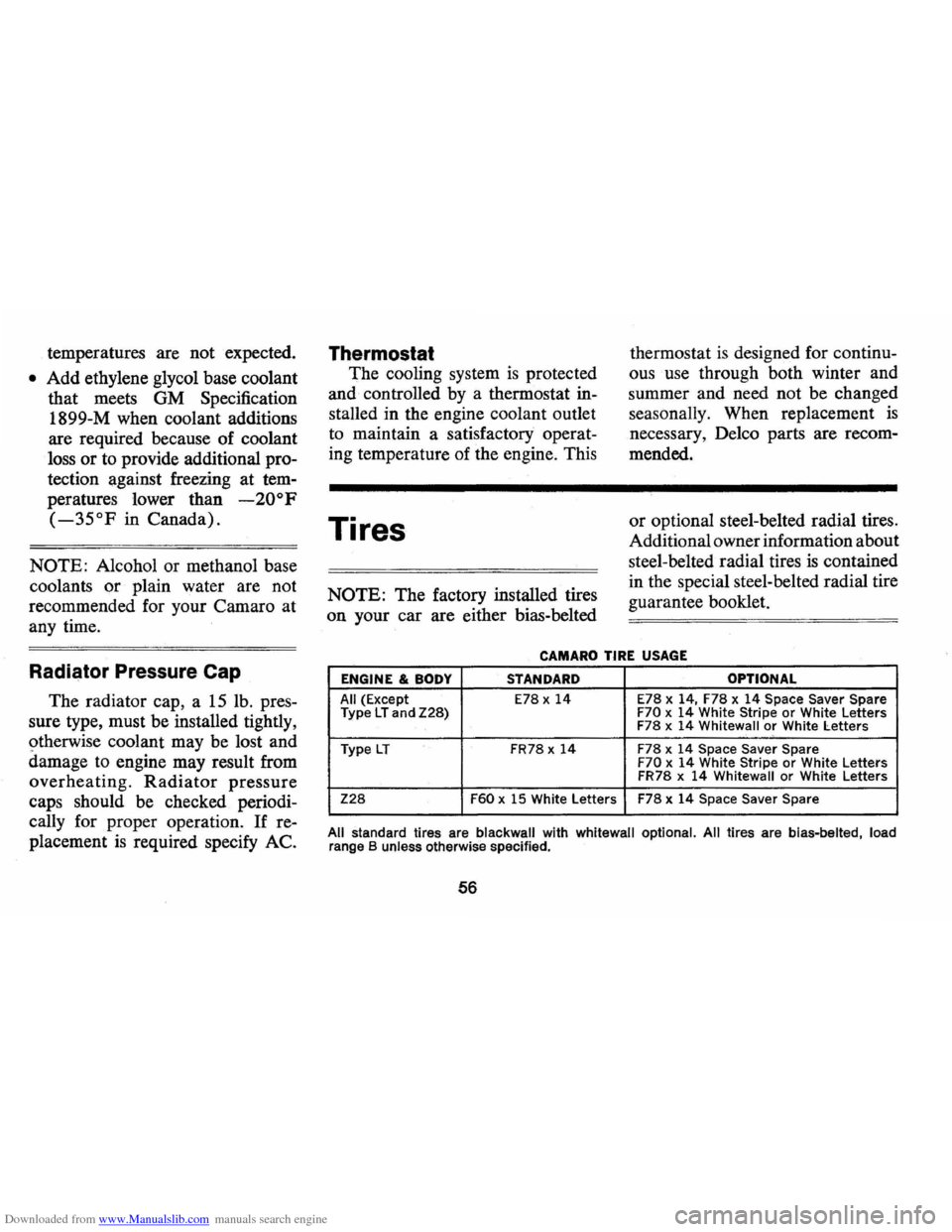
Downloaded from www.Manualslib.com manuals search engine temperatures are not expected.
• Add ethylene glycol base coolant
that meets GM Specification
1899-M when coolant additions
are required because of coolant
loss or to provide additional pro
tection against freezing at tem
peratures lower than
-20°F
(-35°F in Canada).
NOTE: Alcohol or methanol base
coolants or plain water are not
recommended for your Camaro at
any time.
Radi~tor Pressure Cap
The radiator cap, a 15 lb. pres
sure type, must be installed tightly,
9therwise coolant may be lost and
damage to engine may result from
overheating.
Radiator pressure
caps should be checked periodi
cally for proper operation.
If re
placement
is required specify AC.
Thermostat
The cooling system is protected
and controlled by a thermostat in
stalled in the engine coolant outlet
to maintain a satisfactory operat
ing temperature of the engine. This
Tires
NOTE: The factory installed tires
on your car are either bias-belted thermostat
is designed
for continu
ous
. use through both winter and
summer and need not be changed
seasonally. When replacement
is
necessary, Delco parts are recom
mended.
or optional steel-belted radial tires.
Additional owner information about
steel-belted radial tires
is contained
in the special steel-belted radial tire
guarantee booklet.
CAMARO TIRE USAGE
ENGINE & BODY STANDARD OPTIONAL
All (Except E78 x 14 E78 x 14, F78 x 14 Space Saver Spare
Type LTand Z28) F70 x 14 White Stripe or White Letters
F78 x 14 Whitewall or White Letters
Type
LT FR78 x 14 F78 x 14 Space Saver Spare F70 x 14 White Stripe or White Letters
FR78 x 14 Whitewall or White Letters
Z28 F60 x 15 White Letters F78 x 14 Space Saver Spare
All standard tires are blackwall with whitewall optional. All tires are bias-belted load range B unless otherwise specified. '
56
Page 60 of 85
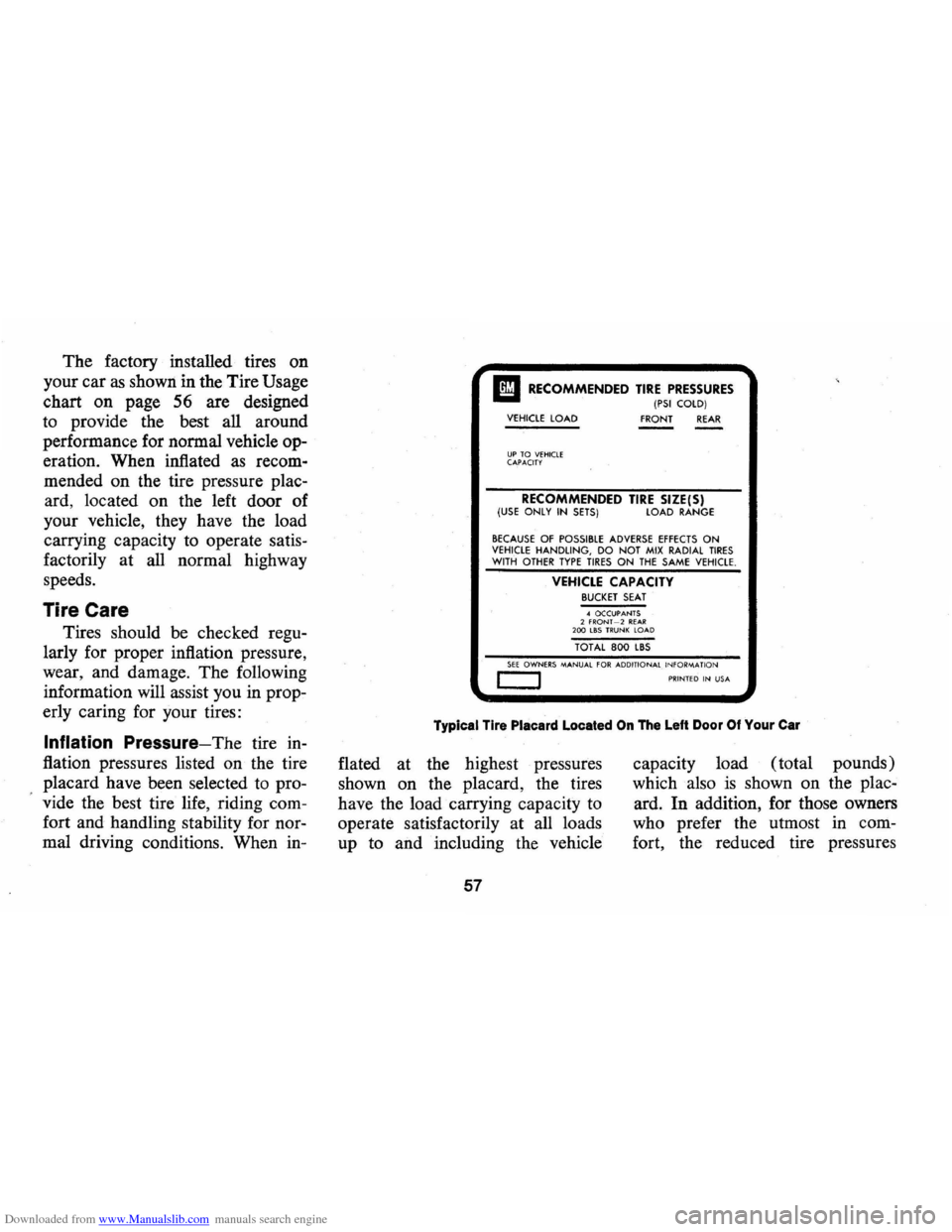
Downloaded from www.Manualslib.com manuals search engine The factory installed tires on
your car as shown in the Tire Usage
chart
on page 56 are designed
to provide the best all around
performance for normal vehicle op
eration. When inflated as recom
mended on the tire pressure plac
ard, located
on the left door of
your vehicle, they have the load
carrying capacity to operate satis
factorily at all normal highway
speeds.
Tire Care
Tires should be checked regu
larly for proper inflation pressure,
wear, and damage. The following
information will assist you in prop
erly caring for your tires:
Inflation Pressure-The tire in
flation pressures listed on the tire
placard have been selected to pro
vide the best tire life, riding com
fort and handling stability for nor
mal driving conditions. When in-
I! RECOMMENDED TIRE PRESSURES (PSI COlD) VEHICLE LOAD
FRONT REAR
UP TO VEHiClE CAPACITY
RECOMMENDED TIRE SIZE(S) (USE ONLY IN SETS) LOAD RANGE
BECAUSE OF POSSIBLE ADVERSE EFFECTS ON VEHICLE HANDLING, DO NOT MIX RADIAL TIRES WITH OTHER TYPE TIRES ON THE SAME VEHICLE.
VEHICLE CAPACITY BUCKET SEAT .. OCCUPANTS 2 fRONf -2 Rf.A.R 200 LBS TRUNK LOAD
TOT AL 800 L8S
SEE OWNERS MANUAL FOR ADDITIONAL INFORM-A nON c:::::J PRINTED IN USA
Typical Tire Placard Located On The Left Door Of Your Car
flated at the highest pressures
shown
on the placard, the tires
have the load carrying capacity to
operate satisfactorily at all loads
up to and including the vehicle
57
capacity load (total pounds)
which also
is shown on the plac
ard.
In addition, for those owners
who prefer the utmost in com
fort, the reduced tire pressures
Page 61 of 85
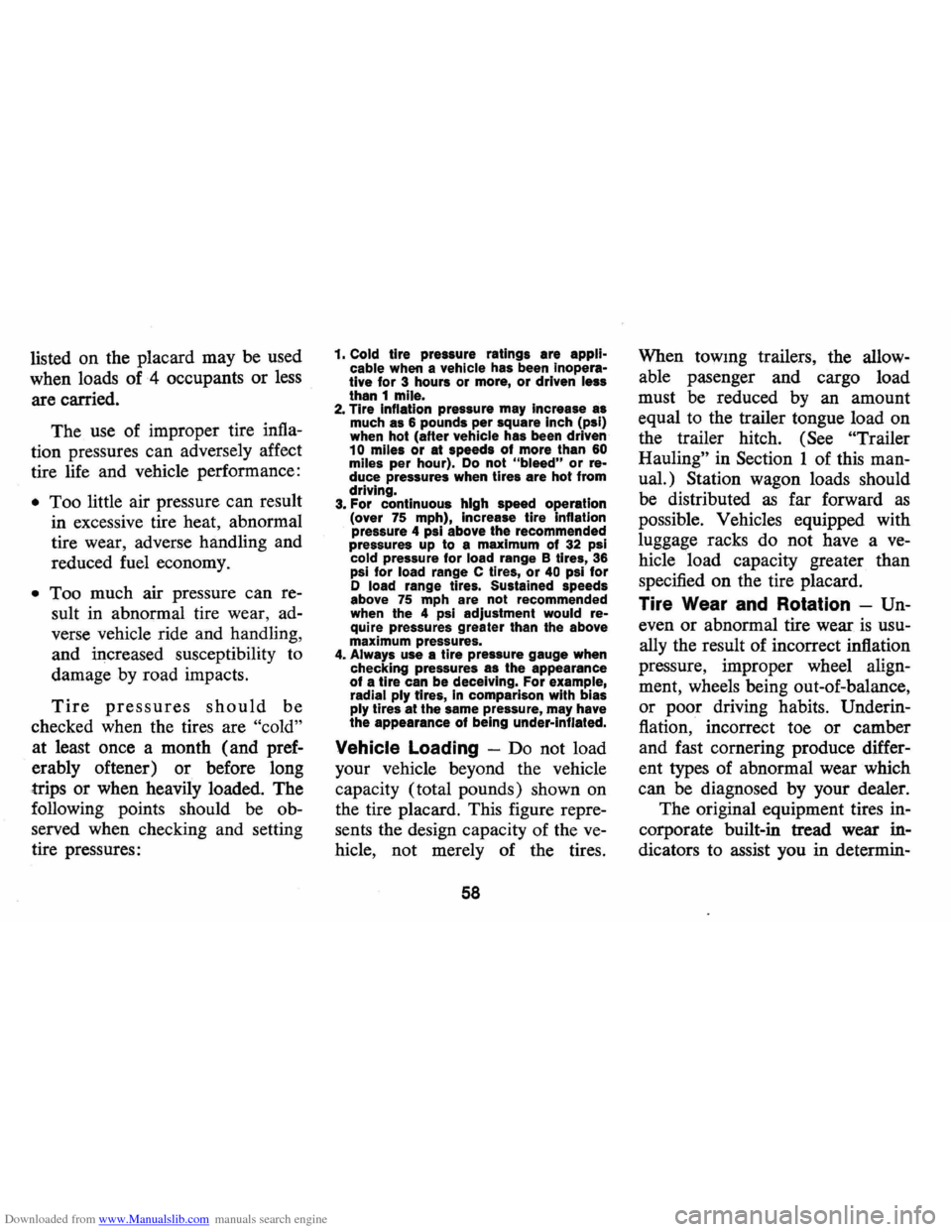
Downloaded from www.Manualslib.com manuals search engine listed on the placard may be used
when loads of
4 occupants or less
are carried.
The use of improper tire
infla
tion pressures can adversely affect
tire life and vehicle performance:
• Too little air pressure can result
in excessive tire heat, abnormal
tire wear, adverse handling and
reduced fuel economy.
• Too much air pressure can re
sult in abnormal tire wear, ad
verse vehicle ride and handling,
and increased susceptibility to
damage by road impacts.
Tire pressures should be
checked when the tires are "cold"
at least once a month (and pref
erably oftener) or before long
trips or when heavily loaded. The
following points should
be ob
served when checking and setting
tire pressures:
1. Cold tire pressure ratings are applicable when a vehicle has been Inoperative for 3 hours or more, or driven less
than 1 mile.
2. Tire Inflation pressure may Increase as
much as 6 pounds per square inch (psi)
when hot (aHer vehicle has been driven
10 miles or at speeds of more than 60 miles per hour). Do not "bleed" or reduce pressures when tires are hot from
driving.
3. For continuous high speed operation
(over 75 mph), Increase tire inflation
pressure 4 psi above the recommended
pressures up
to a maximum of 32 psi
cold pressure for load range B tires, 36
psi for load range C tires, or 40 psi for D load range tires. Sustained speeds
above 75 mph are not recommended
when the 4 psi adjustment would require pressures greater than the above
maximum pressures.
4. Always use a tire pressure gauge when
checking pressures as the appearance
of a tire can be deceiving. For example,
radial ply fires, In comparison with bias
ply tires at the same pressure, may have
the appearance of being under-inflated.
Vehicle Loading -Do not load
your vehicle beyond the vehicle
capacity (total pounds) shown on
the tire placard. This figure
repre
sents the design capacity of the ve
hicle, not merely of the tires.
58
When towmg trailers, the allow
able pasenger and cargo load
must be reduced by an amount
equal to the trailer tongue load on
the trailer hitch.
(See "Trailer
Hauling"
in Section 1 of this man
ual.) Station wagon loads should
be distributed
as far forward as
possible. Vehicles equipped with
luggage racks do not have a
ve
hicle load capacity greater than
specified on the tire placard.
Tire Wear and Rotation -Un
even or abnormal tire wear is usu
ally the result of incorrect inflation
pressure, improper wheel
align
ment, wheels being out-of-balance,
or poor driving habits.
Underin
flation, incorrect toe or camber
and fast cornering produce
differ
ent types of abnormal wear which
can be diagnosed by your dealer.
The original equipment tires
in
corporate built-in tread wear in
dicators to assist you in determin-
Page 62 of 85
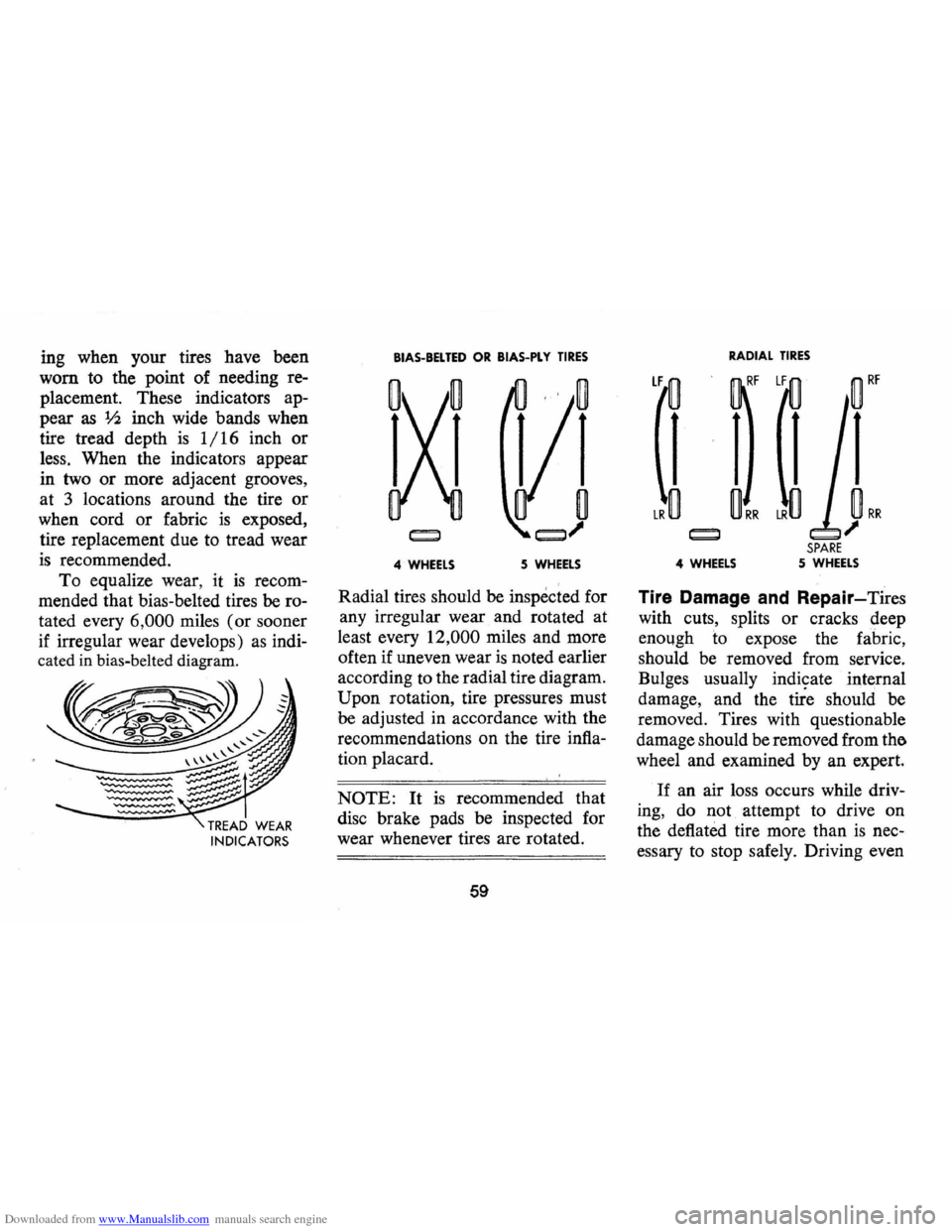
Downloaded from www.Manualslib.com manuals search engine ing when your tires have been
worn to the point of needing re
placement. These indicators ap
pear as
lh inch wide bands when
tire tread depth
is 1/16 inch or
less. When the indicators appear
in two
or more adjacent grooves,
at 3 locations around the tire
or
when cord or fabric is exposed,
tire replacement due to tread wear
is recommended.
To equalize wear, it is recom
mended that bias-belted tires be ro
tated every
6,000 miles (or sooner
if irregular wear develops) as indi
cated in bias-belted diagram.
BIAS-BEL TED OR BIAS-PlY TIRES
4· WHEELS 5 WHEELS
Radial tires should be inspected for
any irregular wear
and rotated at
least every
12,000 miles and more
often if uneven wear
is noted earlier
according to the radial tire diagram.
Upon rotation, tire pressures must
be adjusted in accordance with the
recommendations
on the tire infla
tion placard.
NOTE: It is recommended that
disc brake pads be inspected for
wear whenever tires are rotated.
59
RADIAL TIRES
SPARE 4 WHEELS 5 WHEELS
Tire Damage and Repair-Tires
with cuts, splits or cracks deep
enough to expose the fabric,
should be removed from service.
Bulges usually
indi~ate internal
damage, and the tire should be
removed. Tires with questionable
damage should be removed from
the.
wheel and examined by an expert.
If an air loss occurs while driv
ing, do not attempt to drive on
the deflated tire more than
is nec
essary to stop safely. Driving even